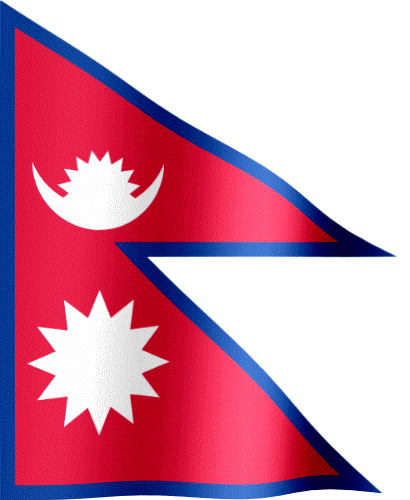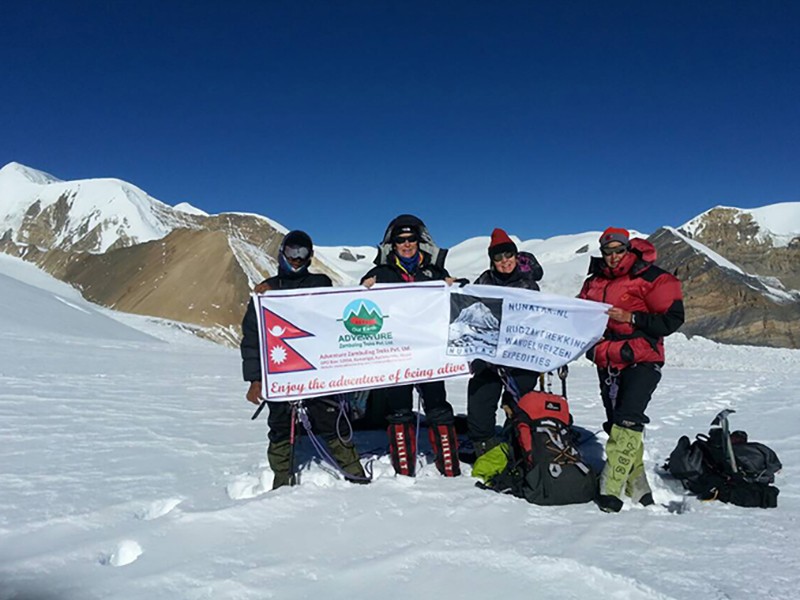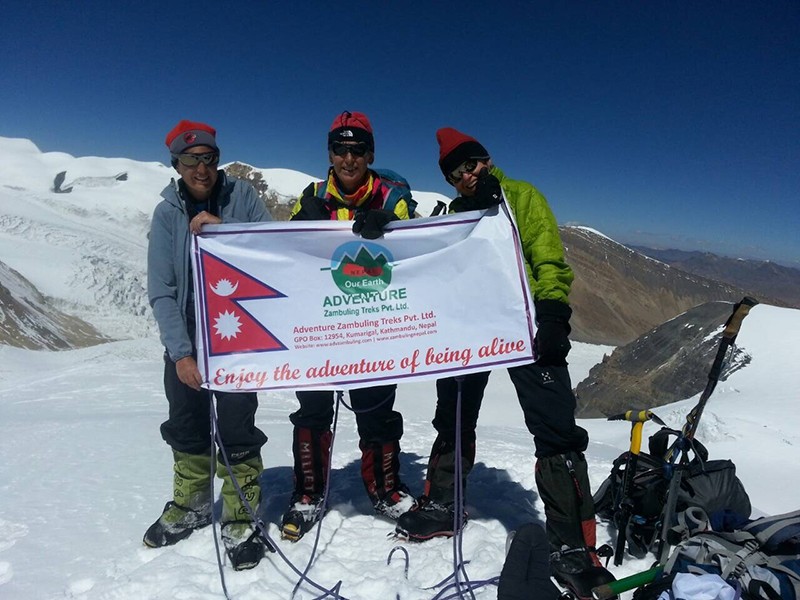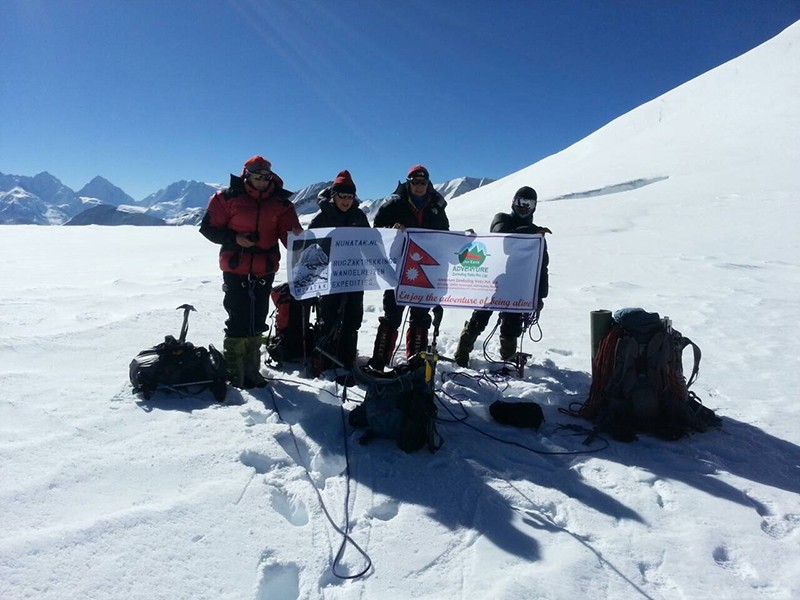Reference Code: SBE
Trip Start: Jomsom
Maximum Altitude: 6346m
Age: 20 years to 60 years
Season: Autumn
Accommodation: Camp
Service: Full board
Destination: Nepal
Trip End: Besisahar
Trip Durations: 25
Peak Grade: Hard
Physical Rating: Strenuous
Group Size: 2-12
Theme: Expedition
Meals: Standard
Saribung Peak Climbing has introduced peak expedition in the mid-western region of Nepal. The Saribung peak lies in the remote part of Mustang in the vicinity of Damodar Himal. It is an ideal expedition that includes exploration of Upper Jomsom, Mustang, Naar Phu valley, and Hidden Valley. During the Saribung Peak Trek, we will pass through several villages and it offers the opportunity to experience the diverse and fascinating cultures.
Very few climbers have managed to conquer the summit of Saribung Peak. Saribung Peak is an excellent opportunity for those wishing to gain climbing experience as well as explore the less beaten region of Nepal. The ascent to the summit of Saribung Trekking is additionally thought of a rather straightforward peak ascension with relatively less technical sections.
During this trek, the summit rewards us with magnificent views of Mountains like Nilgiri Himal, Himlung Himal, Lamjung Himal, Mt Manaslu, and Annapurna II. The best time to go for this trek is from March to May and September to November. Since the trail is challenging and has slippery ice, one need to be physically and mentally fit to go this trek.
Inclusion
Lodge/Camping Basis
All ground transportation as per itinerary
3 night hotel accommodation in Kathmandu with B/B plan.
3 night hotel accommodation in Pokhara with B/B plan.
TIMs (Trekking Information Management system) card
Annapurna Conservation Area Entry fee
Peak climbing permit
Food for the members on Lodge/Camping basis
Lodge charges
All camping equipment and camping charges during climbing period
All required group climbing equipments( like fixed ropes, man rope, ice bar, ice screw.....)
All required Nepalese staffs including climbing support sherpa
Climbing support Sherpa equipments
All Nepalese staffs insurance
Company service charge and government taxes etc.
Exclusion
International flight with airport tax.
Nepalese Entry Visa fee
Food during stay in Kathmandu and Pokhara
All personal equipment and personal expenses
All personal climbing gears
Photography Charges, Monument charges and Monument entry fees
Personal Medical and travel insurance(must cover helicopter rescue evacuation cost)
Personal Medicine
Telephone and internet charges
Laundry charges
Alcoholic beverage, bottled drinks and cold drinks during the trip
Rescue evacuation charges if required
Staff and porters Tips...
This trekking equipment list has been prepared by Adventure Zambuling Treks (P) Ltd.
Climbing equipment:
» Climbing harness;
» One 3 metre/10 foot sling and three 2 metre/6 foot slings.
» Figure 8/Abseil belay device;
» 1 large mitten sized ascender (most members use the large petzl) and arm length leash;
» 2 locking carabiners, (1 large and 1 small)
» 4 regular carabiners;
» Good quality Ice axe with leash;
» Crampons - must fit boots perfectly. Steel crampons with anti-balling (anti-bot) plates are the best;
» Optional; Adjustable trekking poles;
Upper Body:
» 2 cotton t-shirts;
» 1 polypropylene t-shirt;
» 1 long sleeve polypropylene shirts, lightweight;
» 1 polar fleece pullovers, medium weight;
» 1 polar fleece jacket.
» Gore-Tex jacket with hood, waterproof and breathable;
» Lightweight down jacket for those chilly days in camp;
Hands:
» 1 pr. lightweight poly-liner gloves. These will be worn when tying knots, but not inside your mitts;
» 1 pair mittens, consists of 1 Gore-tex over mitt matched with the very warm polar fleece mitt liner (For more about high altitude mitts.
Head:
» Warm hat wool or synthetic that covers your ears;
» Balaclava;
» Face mask;
» Ballcap or brimmed suncap;
» Glacier sunglasses with side shields (you can purchase these inexpensively in Kathmandu,
» 1 pair ski goggles (Optional) with light and dark lens;
» Headlamp with extra batteries and bulbs;
» Bandana or head scarf, also useful for dusty conditions.
Lower Body:
» Cotton underwear briefs;
» 1 pair walking shorts;
» 1 pair walking trousers for trekking and around camp;
» 1 pair lightweight thermal bottoms;
» 1 pair medium or expedition weight thermal bottoms;
» 1 pair polar fleece trousers;
» 1 pair Gore-Tex trousers, salopettes, or bibs. Waterproof/breathable with full side zips;
Your clothing should be kept dry using waterproof stuff sacks, bin-liners, or large plastic bags.
Feet:
» 1 pair Double Plastic boots (Koflach);
Modern single waterproof-leather climbing boots with special insulation for cold weather/winter climbing on 4000 metre/13,000 foot high peaks are OK, as long as they will fit comfortably with two thick pair of socks and a vapour barrier liner and the boot will fit the crampon perfectly.
» 1 pair sturdy leather walking boots with good ankle support (we mean leather trekking, not climbing boots) for the trek;
» 1 pair trainers, running shoes and/or sandals for Kathmandu and in camp;
» 1 pair down booties (optional);
» 2 pair med-heavy poly or wool socks;
» 2- pair of liner socks. Polypropylene or wool;
» Vapour barrier liner socks or plastic bread-bags;
» 2 pair lightweight trekking socks, poly or wool;
» Cotton socks for in town.
Sleeping:
» 1 good quality sleeping bag (good to -30 degrees C)
» At least 1 closed cell foam kari-mats. We do not recommend inflatable mats, as we have never seen one not puncture. You can buy these non inflatable mats very inexpensively in Kathmandu. Why carry foam mats around the world, when you can purchase them inexpensively in Kathmandu?
Your sleeping bags should be kept dry using waterproof stuff sacks, bin-liners, or large plastic bags.
Rucksack and Travel Bags:
» 1 medium rucksack (50-70 litres / 3000-4500 cubic inches, can be used for airplane carry);
» 1 or 2 large (120 L / 7500 cubic inch) duffle kit bags for clothing and equipment. Must be durable for use on pack animals or porters;
» Small padlocks for duffel kit bags.
Personal Hygiene:
» female or male hygiene supplies;
» 2 tubes lip sun cream, 1 large tube skin sun cream (min.factor 15);
» anti-mosquito cream;
» 1 toothpaste/brush;
» 1 bar soap or hand sanitizer gel/1 small towel;
» hand wipes.
Medical:
Medications are inexpensive and readily available in Kathmandu with no Doctor`s prescription:
» small personal first-aid kit. (Simple and Light) Aspirin, first-aid tape, plasters (band-aids), personal medications, etc. The leaders will have extensive first-aid kits, so leave anything extra behind. Please let your leader know about any medical issues before the climb;
» 1 skin blister repair kit;
» 1 small bottle anti-diarrhea pills;
» 1 small bottle anti-headache pills;
» 1 small bottle cough and/or cold medicine;
» 1 small bottle stomach antibiotic: Ciprofloxacin, etc.;
» 1 small bottle anti-altitude sickness pills: Diamox, Acetylzolamide.
» Do not bring sleeping pills. They are a respiratory depressant;
» 1 small bottle of water purification tablets or water filter;
» 1 set earplugs;
» Extra prescription glasses, contact lens supplies. Contact lens wearers, please bring glasses in case of emergency. A new pair could be quickly made in Kathmandu, Lhasa, or Kashgar for just $20. Please order upon arrival if you are interested.
Personal Food:
On the mountain we supply plenty of food for you to cook 3 hot meals each day. This food will consist of soup, local cheese & sausage, biscuits, dried noodles, potatoes, rice, porridge, butter, dried and tinned vegetables, fruit, meats, and fish, tea with milk and sugar, powdered juice drink, and drinking chocolate. Our sherpas/local porter will be carrying this food to the higher camps.
» We ask each member to bring their own imported daily snack and energy foods. We do not provide cold “snack” food such as chocolate or "energy-bars". We ask that you bring or buy your own "snack" or daily cold energy food, 2-3 kilos/4-6 pounds is a good amount (for the trek and Island Peak combined). A growing variety of imported foods such as European and American cheeses, chocolates, biscuits, cookies, nuts, and locally made power-bars are now available in Kathmandu, at realistic prices. However, imported power bars, GU, re-hydration drinks, dehydrated food, "freeze-dried meals", imported cheese and sausage are not available. If you want these items, you must bring them from your home country. Many of our members, especially Britons, Europeans, and Australians with tiny baggage allowances, now purchase their daily snacks in Kathmandu. Our schedule in Kathmandu allows plenty of time for shopping.
Practical:
» 1 small roll of repair tape, 1 sewing repair kit;
» 1 cigarette lighter, 1 small box matches;
» 1 compass or GPS;
» Recent good quality map of visiting area.
» 1 battery powered alarm clock/watch;
» 1 camera and film, or digital camera with extra cards and extra batteries;
» nylon stuff sacks For food and gear storage, large Ziplocs are useful also;
» 3 Water bottles (1 litre) wide-mouth Nalgene (1 is a pee bottle);
» 1 plastic cup and spoon;
» 1 small folding knife;
» binoculars (optional);
» 4 large, waterproof, disposable rubbish sacks;
» passport, 2 extra passport photos, flight ticket, flight itinerary;
» separate photocopies of passport and relevant visa pages, proof of insurance;
» dollars, pounds or euros cash for purchasing Nepalese visa at Kathmandu airport, Tibet visa, for paying for restaurants and hotels, for gratuities, snacks, and to purchase your own drinks and gifts;
» credit cards, Bank/ATM/Cash machine cards for use for withdrawing funds from cash machines (bring a photocopy of your cards), traveler's checks, etc.;
» 1 bathing suit/swimming costume (you never know);
» basecamp entertainment. It is good to bring additional items which you have found to be useful on previous expeditions. For example: paperback books, playing cards, ipod mp3 player, short-wave radio, game boys, musical instruments, ear plugs, lots of batteries, etc.;
» travel clothes for basecamp and in town;
This Peak Climbing equipment list has been prepared by Adventure Zambuling Treks (P) Ltd.
Please submit any equipment questions or concerns to: info@advzambuling.com






